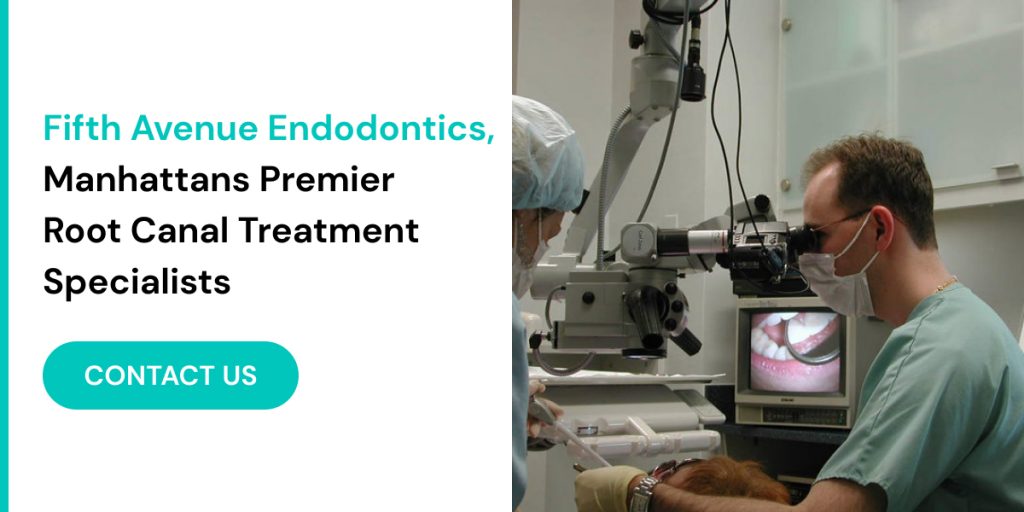A root canal is a highly successful procedure for saving teeth with infected or inflamed pulp. However, sometimes retreatment becomes necessary. If you’re facing the possibility of a root canal retreatment in Manhattan, it’s natural to have concerns about the cost. Here at Fifth Avenue Endodontics, Dr. Iofin, a leading endodontist with extensive experience, understands these concerns. We prioritize patient well-being and strive to provide transparent communication about treatment options and associated costs. This blog post aims to shed light on the factors affecting the cost of Manhattan root canal retreatment and explore options like dental insurance coverage. By understanding these factors, you can make informed financial decisions about your oral health.
In the next section, we’ll delve deeper into the specific factors that influence the cost of root canal retreatment in Manhattan. We’ll also explore how dental insurance can help manage these costs and the importance of considering the long-term value of saving your natural tooth through retreatment.
Why Might You Need Root Canal Retreatment? Understanding the Reasons Behind a Second Chance
While root canals boast a high success rate, there are situations where a tooth might require retreatment. This doesn’t necessarily mean the initial procedure failed; sometimes, unforeseen circumstances arise. Here’s a closer look at the most common reasons why retreatment becomes necessary:
- Incomplete Initial Treatment: The root canal system of a tooth can be complex, with intricate canals that vary in size and shape. During the initial procedure, narrow or curved canals can sometimes be missed. These hidden passageways can harbor infected pulp tissue or bacteria, leading to future problems. Additionally, some teeth have very small accessory canals that might be difficult to detect with traditional techniques. Advancements in dental technology, like cone beam CT scans, can help improve visualization and ensure all canals are addressed during retreatment.
- Reinfection: A crown or filling placed after the initial root canal is designed to create a seal and prevent future problems. However, this seal can break down over time due to wear and tear, trauma, or decay. This allows bacteria from your mouth to seep back into the treated canals, reintroducing infection and necessitating retreatment. Cracks or chips in the tooth itself can also provide a pathway for bacteria, leading to the same issue.
- Persistent Inflammation: Even with a seemingly successful initial root canal, residual bacteria or tissue fragments can sometimes remain within the canals. This can trigger chronic inflammation around the root of the tooth, causing pain, swelling, and discomfort. Additionally, if the initial cleaning wasn’t thorough enough or the crown wasn’t properly sealed, persistent leakage can irritate the surrounding tissues, leading to ongoing inflammation. In these cases, retreatment allows for a more thorough cleaning and disinfection of the canals to address the source of the inflammation and promote healing.
- Post-Treatment Complications: In rare instances, complications can arise after the initial root canal that necessitate retreatment. These might include:
- Broken instruments: During the initial procedure, a dental instrument used to clean the canals could break off and become lodged within the root. This can complicate retreatment but is usually manageable by an experienced endodontist.
- Anatomical challenges: Some teeth have unusual anatomy, like a curved root or a very narrow opening. While these can be addressed during the initial procedure, they might pose a greater challenge during retreatment due to scar tissue formation or changes in the tooth structure.
Understanding the reasons behind root canal retreatment can help alleviate any anxieties you might have. If you’re experiencing persistent pain or discomfort in a previously treated tooth, it’s crucial to schedule a consultation with an endodontist for a proper diagnosis. Early intervention can often prevent the need for more complex retreatment procedures.
In the next section, we’ll explore the factors influencing the cost of root canal retreatment in Manhattan and how dental insurance can help manage these expenses. We’ll also delve into the long-term benefits of saving your natural tooth through retreatment.
Understanding the Cost of Manhattan Root Canal Retreatment: Factors to Consider
The cost of Manhattan root canal retreatment can vary depending on several factors. Here’s a deeper dive into the key elements that influence the price:
- Complexity of the Case: Retreatment is often more intricate than the initial root canal because the tooth has already undergone treatment. The complexity is primarily determined by:
- Number of Canals: Teeth have varying numbers of canals (narrow passageways within the root containing nerves and blood vessels). Molars, for example, typically have more canals than front teeth. Retreating a tooth with more canals generally requires more time and specialized techniques, thus potentially increasing the cost.
- Location of the Tooth: The location of the tooth in your mouth can also impact the cost. Front teeth are generally easier to access and navigate compared to molars in the back of the mouth. Easier access translates to potentially less treatment time and a potentially lower cost.
- Presence of Additional Procedures: In some cases, additional procedures might be necessary during retreatment. For example, if a broken instrument is lodged within the canal from the initial procedure, its removal might require surgical intervention. These additional procedures can significantly impact the overall cost.
- Experience of the Endodontist: Endodontists are dentists who specialize in diagnosing and treating root canal problems. Their advanced training and experience in complex procedures like retreatment can influence the cost. Dr. Iofin, a leading endodontist at Fifth Avenue Endodontics, brings extensive experience and expertise to Manhattan root canal retreatment. This expertise often translates to increased efficiency and a higher success rate, potentially reducing the need for additional procedures down the line. While the initial cost might seem higher, it can lead to cost savings in the long run.
- Diagnostic Tests: Accurate diagnosis is crucial for successful retreatment. Diagnostic tests like X-rays and potentially cone beam CT scans help Dr. Iofin visualize the root canal system, identify any hidden canals, and determine the extent of the retreatment needed. The number and type of tests required can vary depending on the complexity of the case and can affect the overall cost.
It’s important to note that Fifth Avenue Endodontics prioritizes transparency in communication. We understand the financial considerations involved in dental procedures. During your consultation, Dr. Iofin will thoroughly examine your tooth, discuss the recommended retreatment plan, and provide a clear cost estimate before proceeding with treatment.
In the next section, we’ll explore how dental insurance can help manage the cost of Manhattan root canal retreatment and delve into the long-term benefits of saving your natural tooth through retreatment.
Dental Insurance and Root Canal Retreatment: Navigating Your Coverage Options
While the cost of root canal retreatment in Manhattan can be a concern, most dental insurance plans offer some level of coverage to help alleviate the financial burden. However, understanding the intricacies of your specific plan and its coverage details is crucial for informed decision-making. Here’s a breakdown of key factors to consider regarding dental insurance and root canal retreatment:

- In-Network vs. Out-of-Network Coverage: Dental insurance plans typically maintain a network of in-network providers who have pre-negotiated rates for various procedures. Choosing Fifth Avenue Endodontics, an in-network provider for many insurance plans in Manhattan, can significantly reduce your out-of-pocket expenses. In-network providers agree to accept the negotiated fees as full payment, minimizing the amount you’ll be responsible for after insurance. Conversely, choosing an out-of-network provider might mean you’ll pay the full cost of the procedure and then be reimbursed by your insurance company according to their predetermined out-of-network rates, which are typically lower than in-network rates.
- Deductible: Most dental insurance plans have a deductible, which is a yearly amount you’re responsible for paying before your insurance coverage kicks in. This means you’ll shoulder the cost of treatment up to your deductible amount. For example, if your deductible is $2,000 and your root canal retreatment costs $3,000, you’d be responsible for the first $2,000, and your insurance would cover the remaining $1,000. It’s important to understand your specific deductible amount before undergoing treatment.
- Co-payment: A co-payment is a fixed amount you pay for a covered dental service, regardless of the total treatment cost. Some insurance plans might have a co-payment specifically for root canal retreatment. This co-payment is typically a fixed dollar amount (e.g., $100) that you’d pay upfront for the procedure, with your insurance covering the remaining covered amount according to your plan.
- Coverage Limitations: Dental insurance plans often have limitations on specific procedures, including root canal retreatment. These limitations might involve:
- Annual Maximums: Some plans have annual maximums, which represent the total amount your insurance company will pay for covered services within a calendar year. This means that once you reach your annual maximum, you’ll be responsible for the full cost of any additional covered services for the remainder of the year.
- Frequency Limitations: Certain plans might have limitations on the frequency of certain procedures, including root canal retreatment. For example, your plan might only cover one root canal retreatment per tooth within a specific timeframe (e.g., five years).
Maximizing Your Insurance Coverage for Root Canal Retreatment
To maximize your insurance coverage for Manhattan root canal retreatment, consider these tips:
- Contact Your Insurance Company: The best first step is to get a clear understanding of your specific dental insurance plan and its coverage details for root canal retreatment. Contact your insurance provider and ask them about:
- In-network coverage for endodontic services.
- The amount of your deductible and co-payment for root canal retreatment.
- Any annual maximums or frequency limitations that might apply.
- Schedule a Consultation with Dr. Iofin: Once you have a better understanding of your coverage, schedule a consultation with Dr. Iofin at Fifth Avenue Endodontics. Our team can provide a detailed treatment plan and a clear cost estimate after a thorough examination. We can also work directly with your insurance company to verify your coverage and pre-determine your estimated out-of-pocket expenses for the retreatment procedure.
- Consider Treatment Timing: If your plan has an annual maximum, strategically scheduling your treatment within the calendar year can help you optimize your coverage.
By understanding your dental insurance plan and working collaboratively with Fifth Avenue Endodontics, you can navigate the financial aspects of root canal retreatment and make informed decisions about your oral health.
In the next section, we’ll explore the long-term value of saving your natural tooth through root canal retreatment, highlighting the benefits that go beyond simply alleviating pain.
Financial Considerations: Planning for Manhattan Root Canal Retreatment and Investing in Your Smile’s Future
The cost of Manhattan root canal retreatment is a valid consideration. Here at Fifth Avenue Endodontics, we understand the importance of financial planning for dental procedures. We prioritize transparency and offer several resources to help you manage the cost of retreatment:
- Understanding Your Insurance Coverage: The first step is to get a clear picture of your dental insurance plan and its coverage details for root canal retreatment. Contact your insurance provider directly and inquire about:
- In-Network Coverage: As mentioned previously, choosing Fifth Avenue Endodontics, an in-network provider for many insurance plans, can significantly reduce your out-of-pocket expenses due to pre-negotiated rates.
- Coverage Specifics: Ask about your deductible, co-payment for root canal retreatment, and any annual maximums or frequency limitations that might apply to your plan. This knowledge empowers you to create a budget for the procedure.
- Consultation and Cost Estimate: Schedule a consultation with Dr. Iofin at Fifth Avenue Endodontics. During this consultation, Dr. Iofin will conduct a thorough examination of your tooth and discuss the recommended retreatment plan. Following the examination, our team will provide you with a transparent and detailed cost estimate tailored to your specific situation. This estimate will factor in your insurance coverage and any potential out-of-pocket expenses.
- Flexible Payment Options: We understand that treatment costs can vary, and we strive to make treatment accessible to everyone. Fifth Avenue Endodontics offers flexible payment options to help manage the financial aspects of your root canal retreatment. Our team can discuss these options with you in detail during your consultation.
Beyond Cost: The Long-Term Value of Saving Your Natural Tooth
While cost is a factor, it’s crucial to consider the long-term value of saving your natural tooth through root canal retreatment. Here’s why prioritizing retreatment might be a worthwhile investment in your oral health and overall well-being:
- Preserves the Natural Tooth Structure: Natural teeth boast a unique structure that promotes optimal chewing function and aesthetics. Dental implants or bridges, while effective solutions for tooth replacement, don’t replicate the intricate functionality and natural appearance of your original tooth. Root canal retreatment helps you preserve this natural advantage.
- Prevents Future Complications: Leaving an infected tooth untreated can lead to serious complications down the line, including bone loss, jaw pain, and even the potential loss of neighboring teeth. Retreatment addresses the underlying infection at its source, preventing these future issues and promoting long-term oral health.
- Improves Overall Well-being: A healthy smile is more than just about aesthetics; it plays a vital role in overall well-being. Studies have shown a correlation between oral health and general health. Saving your natural tooth through retreatment contributes to a healthier mouth and potentially better overall health.
By understanding the financial considerations and the long-term benefits of root canal retreatment, you can make informed decisions about your oral health. At Fifth Avenue Endodontics, Dr. Iofin and our dedicated team are committed to providing exceptional care, transparent communication, and flexible financial options to help you achieve a healthy smile.
Investing in Your Oral Health: The Long-Term Benefits of Saving Your Natural Tooth Through Retreatment
The cost of Manhattan root canal retreatment is a valid concern. However, it’s crucial to weigh this cost against the long-term benefits of saving your natural tooth. Here’s why prioritizing retreatment might be a worthwhile investment in your oral health and overall well-being:
- Preserving the Natural Advantage of Your Tooth: Natural teeth boast a complex root system that provides exceptional stability and promotes optimal chewing function. Dental implants, while a significant advancement in dentistry, rely on surgically placed posts to support a replacement crown. This can sometimes lead to issues with chewing efficiency or difficulty cleaning certain areas, potentially impacting long-term oral health. Bridges, on the other hand, require altering healthy teeth on either side of the gap to support the replacement tooth. Saving your natural tooth through retreatment allows you to retain this natural advantage, promoting better chewing function and potentially reducing the risk of future problems with adjacent teeth.
- Preventing a Cascade of Complications: Leaving an infected tooth untreated can have serious consequences down the line. The infection can spread to the surrounding bone, leading to bone loss and potential jaw pain. In severe cases, it might even threaten the health of neighboring teeth. Root canal retreatment addresses the underlying infection at its source, preventing a cascade of complications and promoting long-term oral health. Early intervention can save you from more extensive and potentially expensive procedures in the future.
- A Healthy Smile for a Healthy You: Oral health plays a vital role in overall well-being. Studies have shown a link between chronic oral infections and systemic health issues like heart disease, diabetes, and even pregnancy complications. Saving your natural tooth through retreatment contributes to a healthier mouth, potentially reducing the risk of these associated health problems and promoting overall well-being.
Beyond the immediate benefits of pain relief, root canal retreatment offers a long-term investment in your oral and overall health. By prioritizing your natural tooth, you’re investing in a stronger foundation for a healthy smile and potentially a healthier you.

Conclusion: Taking Charge of Your Oral Health Journey
The cost of Manhattan root canal retreatment can vary, but understanding the factors involved empowers you to make informed financial decisions. By exploring options like dental insurance and discussing flexible payment plans with our team at Fifth Avenue Endodontics, you can invest in a solution that fits your budget.
Remember, prioritizing root canal retreatment isn’t just about addressing immediate pain; it’s a long-term investment in your oral health. Saving your natural tooth preserves its functionality and aesthetics, prevents future complications, and contributes to your overall well-being.
If you’re experiencing discomfort in a previously treated tooth, don’t hesitate to schedule a consultation with Dr. Iofin, a leading endodontist in Manhattan. We offer a comfortable environment and a compassionate team dedicated to providing exceptional care and helping you achieve a healthy smile.

